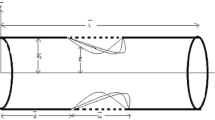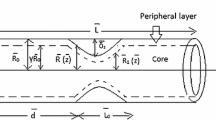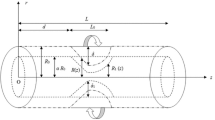Abstract
A novel approach of combined mathematical and computational models has been developed to investigate the oscillatory two-layered flow of blood through arterial stenosis in the presence of a transverse uniform magnetic field applied. Blood in the core region and plasma fluid in the peripheral layer region are assumed to obey the law of Newtonian fluid. An analytical solution is obtained for velocity profile and volumetric flow rate in the peripheral plasma region and also wall shear stress. Finite difference method is employed to solve the momentum equation for the core region. The numerical solutions for velocity, flow rate and flow resistance are computed. The effects of various parameters associated with the present flow problem such as radially variable viscosity, hematocrit, plasma layer thickness, magnetic field and pulsatile Reynolds number on the physiologically important flow characteristics namely velocity distribution, flow rate, wall shear stress and resistance to flow have been investigated. It is observed that the velocity increases with the increase of plasma layer thickness. An increase or a decrease in the velocity and wall shear stress against the increase in the value of magnetic parameter (Hartmann number) and hematocrit is dependent on the value of t. An increase in magnetic field leads to an increase in the flow resistance and it decreases with the increase in the plasma layer thickness and pulsatile Reynolds number. The information concerning the phase lag between the flow characteristics and how it is affected by the hematocrit, plasma layer thickness and Hartmann number has, for the first time, been added to the literature.











Similar content being viewed by others
References
Young DF (1968) Effects of a time-dependent stenosis on flow through a tube. J Eng Ind, Trans ASME 90:248–254
Caro CG (1981) Arterial Fluid Mechanics and Atherogenesis. In: Recent advances in cardiovascular diseases, vol 2(Suppl.), pp 6–11
Distenfass L (1971) Viscosity factors in hypertensive and cardiovascular diseases. Cardiovasc Med 2:337–349
Fry DL (1968) Acute vascular endothelial changes associated with increased blood velocity gradients. Circ Res 22:165–197
Motta M, Haik Y, Gandhari A, Chen CJ (1998) High magnetic field effects on human deoxygenated hemoglobin light absorption. Bioelectrochem Bioenerg 47:297–300
El-Shehawey EF, Elbarbary EME, Afifi NAS, Elshahed M (2000) MHD flow of an elastic-viscous fluid under periodic body acceleration. J Math Math Sci 23:795–799
Midya C, Layek GC, Gupta AS, Roy Mahapatra T (2003) Magnetohydrodynamics viscous flow separation in a channel with constrictions. J Fluid Eng, Trans ASME 125:952–962
Ramachandra Rao A, Deshikachar KS (1988) Physiological type flow in a circular pipe in the presence of a transverse magnetic field. J Indian Inst Sci 68:247–260
Haldar K, Ghosh SN (1994) Effect of a magnetic field on blood flow through an indented tube in the presence of erythrocytes. Indian J Pure Appl Math 25:345–352
Voltairas PA, Fotiadis DI, Michalis LK (2002) Hydrodynamics of magnetic drug targeting. J Biomech 35:813–821
Vardanian VA (1973) Effect of magnetic field on blood flow. Biofizika 18:491–496
Bhargava R, Rawat S, Takhar HS, Beg OA (2007) Pulsatile magneto-biofluid flow and mass transfer in a non-Darcian porous medium channel. Meccanica 42:247–262
Young DF (1979) Fluid mechanics of arterial stenosis. J Biomech Eng, Trans ASME 101:157–175
Forrester JH, Young DF (1970) Flow through a converging and diverging tube and the implications in occlusive vascular disease. J Biomech 3:297–316
Macdonald DA (1979) On steady flow through modeled vascular stenoses. J Biomech 12:13–20
Ogulu A, Abbey TM (2005) Simulation of heat transfer on an oscillatory blood flow in an indented porous artery. Int Commun Heat Mass Transf 32:983–989
Ogulu A, Bestman AR (1993) Deep heat muscle treatment a mathematical model—I & II. Acta Phys Acad Sci Hung 73:3–16 & 17–27
Womersley JR (1955) Oscillatory motion of a viscous liquid in a walled elastic tube. Philos Mag 46:199–221
Kunz AL, Coulter NA Jr. (1967) Non-Newtonian behavior of blood in oscillating flow. Biophys J 7:25–36
Coulter NA, Singh M Jr. (1971) Frequency dependence of blood viscosity in oscillatory flow. Biorheology 8:115–124
Rao AR, Deshikachar KS (1986) MHD oscillatory flow of blood through channels of various cross sections. Int J Eng Sci 24:1615–1628
Haldar K (1987) Osillatory flow of blood in a stenosed artery. Bull Math Biol 49:279–287
Waters SL, Pedley TJ (1999) Oscillatory flow in a tube of time-dependent curvature. Part 1. Perturbation to flow in a stationary curved tube. J Fluid Mech 383:327–352
Moyers-Gonzalez MA, Ovens RG, Fang J (2008) A non- homogeneous constitutive model for human blood. Part III. Oscillatory flow. J Non-Newton Fluid Mech 155:161–173
Kumar S, Kumar S, Kumar D (2009) Research note: oscillatory MHD flow of blood through an artery with mild stenosis. Int J Eng, Trans A: Basics 22:125–130
Greppi M (1978) Numerical solution of a pulsatile flow problem. Meccanica 13:230–237
Beg OA, Bhargava R, Rawat S, Halim K, Takhar HS (2008) Computational modeling of biomagnetic micropolar blood flow and heat transfer in a two-dimensional non-Darcian porous medium. Meccanica 43:391–410
Shahmohamadi H (2011) Reliable treatment of a new analytical method for solving MHD boundary-layer equations. Meccanica 46:921–933
Shahmohamadi H (2012) Analytic study on non-Newtonian natural convection boundary layer flow with variable wall temperature on a horizontal plate. Meccanica 47:1313–1323
Saad EI (2012) Cell models for micropolar flow past a viscous fluid sphere. Meccanica 47:2055–2068
Bugliarello G, Sevilla J (1970) Velocity distribution and other characteristics of steady and pulsatile blood flow in fine glass tubes. Biorheology 17:85–107
Bugliarello G, Hayden JW (1963) Detailed characteristics of the flow of blood in vitro. J Rheol 7:209–230
Haynes RH (1960) Physical basis of the dependence of blood viscosity on these radius. Am J Physiol 198:1193–1205
Sharan M, Popel AS (2001) A two-phase model for flow of blood in narrow tubes with increased effective viscosity near the wall. Biorheology 38:415–428
Shukla JB, Parihar RS, Rao BRP (1980) Effect of peripheral layer viscosity on blood flow through the artery with mild stenosis. Bull Math Biol 42:797–805
Shukla JB, Parihar RS, Rao BRP (1980) Biorheological aspects of blood flow through artery with mild stenosis: effects of peripheral layer. Biorheology 17:403–410
Ikbal MA, Chakravarty S, Mandal PK (2009) Two-layered micropolar fluid flow through stenosed artery, effect of peripheral layer thickness. Comput Math Appl 58:1328–1339
Ponalagusamy R (2007) Blood flow through an artery with mild stenosis: a two-layered model, different shapes of stenoses and slip velocity at the wall. J Appl Sci 7:1071–1077
Ponalagusamy R, Tamil Selvi R (2011) A study on two-layered model (Casson-Newtonian) for blood flow through an arterial stenosis: axially variable slip velocity at the wall. J Franklin Inst 348:2308–2321
Chaturani P, Kaloni PN (1976) Two-layered Poiseuille flow model for blood flow through arteries of small diameter and arterioles. Biorheology 13:243–250
Chaturani P, Ponnalagarsamy R (1982) A two-layered model for blood flow through stenosed arteries. In: Proc of 11th national conf on fluid mechanics and fluid power. BHEL, R&D, Hydrabad, India, pp 16–22
Srivastava VP (1996) Two-phase model of blood flow through stenosed tubes in the presence of a peripheral layer: applications. J Biomech 29:1377–1382
Srivastava VP, Srivastava R (2009) Particulate suspension blood flow through a narrow catheterized artery. Comput Math Appl 58:227–238
Sankar DS, Lee U (2010) Two-fluid Casson model for pulsatile blood flow through stenosed arteries: a theoretical model. Commun Nonlinear Sci Numer Simul 15:2086–2097
Imaeda K, Goodman FO (1980) Analysis of non-linear pulsatile blood flow in arteries. J Biomech 13:1007–1022
Mehrotra R, Jayaraman G, Padmanabhan N (1985) Pulsatile blood flow in a stenosed artery—a theoretical model. Med Biol Eng Comput 23:55–62
Sanyal DC, Maji NK (1999) Unsteady blood flow through an indented tube with atherosclerosis. Indian J Pure Appl Math 30:951–959
El-Khatib FH, Damiano ER (2003) Linear and non-linear analyses of pulsatile blood flow in a cylindrical tube. Biorheology 40:503–522
Venkateshwarlu K, Anand J (2004) Numerical study of unsteady blood flow through an indented tube with atherosclerosis. Indian J Biochem Biophys 41:241–245
Ponalagusamy R (2010) Role of pulsatility on blood flow in an arterial stenosis. Int J Math Eng Comput 1:1–6
Ponnalagarsamy R, Kawahava M (1989) A finite element analysis of laminar unsteady flows of viscoelastic fluids through channels with non-uniform cross-sections. Int J Numer Methods Fluids 9:1487–1501
Philip D, Chandra P (1996) Flow of Eringen fluid (simple micro fluid) through an artery with mild stenosis. Int J Eng Sci 34:87–99
Ponnalagarsamy R (1986) Blood flow through stenosed tube. PhD thesis, IIT, Bombay, India
Haldar K (1985) Effects of the shape of stenosis on the resistance to blood flow through an artery. Bull Math Biol 47:545–550
Ambethkar V, Singh PK (2011) Effect of magnetic field on an oscillatory flow of a viscoelastic fluid with thermal radiation. Appl Math Sci 5:935–946
Cookey IC, Ogulu A, Omubo-Pepple VB (2003) Influence of viscous dissipation and radiation on unsteady MHD free-convection flow past an infinite heated vertical plate in a porous medium with time-dependent suction. Int J Heat Mass Transf 46:2305–2311
Fry DL (1973) Responses of the arterial wall to certain physical factors. In: Atherogenesis: initiating factors. Ciba foundation symp, vol 12, pp 93–125
Caro CG, Fitzgerald JM, Schroter RC (1971) Atheroma and Arterial wall: observation, correlation and proposal of a shear dependent mass transfer mechanism of atherogenesis. Proc R Soc Lond B 177:109–159.
Author information
Authors and Affiliations
Corresponding author
Rights and permissions
About this article
Cite this article
Ponalagusamy, R., Tamil Selvi, R. Blood flow in stenosed arteries with radially variable viscosity, peripheral plasma layer thickness and magnetic field. Meccanica 48, 2427–2438 (2013). https://doi.org/10.1007/s11012-013-9758-z
Received:
Accepted:
Published:
Issue Date:
DOI: https://doi.org/10.1007/s11012-013-9758-z




